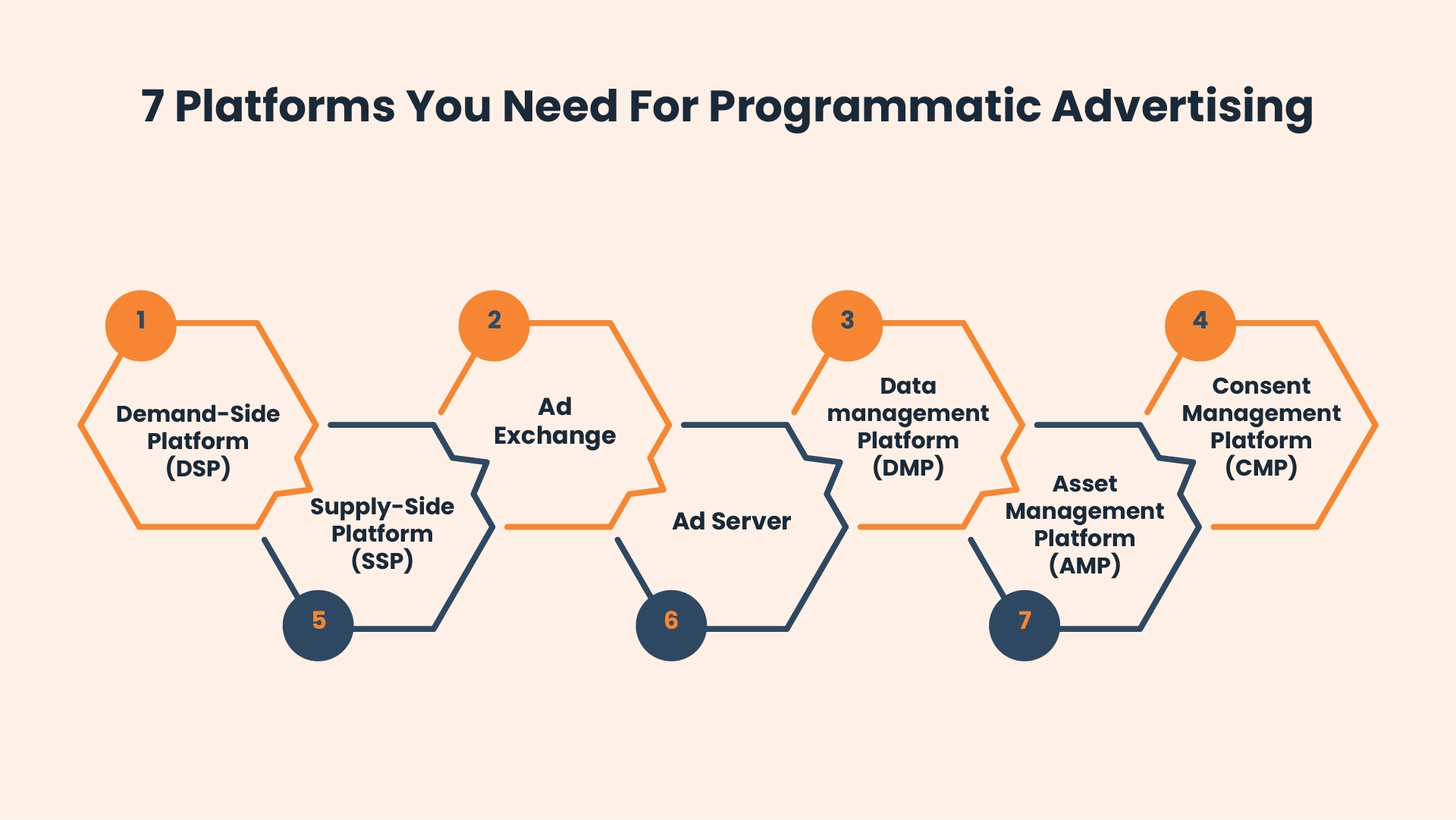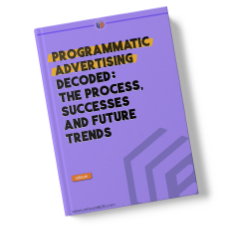
Programmatic Advertising revolves around several platforms that connect advertisers and publishers. Thanks to these tools, concepts like real-time bidding and ad management can work seamlessly. This article is a guide about these programmatic advertising platforms along with some of the best options for each.
7 Types of Programmatic Advertising Platforms
- Demand-Side Platform (DSP)
- Supply-Side Platform (SSP)
- Ad Exchange
- Ad Server
- Data management Platform (DMP)
- Asset Management Platform (AMP)
- Consent Management Platform (CMP)
1. Demand-Side Platform (DSP)
A demand-side platform allows advertisers to buy ad spaces and inventories. The process is automated and happens in real time. A DSP connects advertisers to a variety of ad exchanges and ad networks, to check available inventories.
With accurate targeting being a key priority, DSPs have evolved over the years to match relevant inventories with your campaigns. So once you define characteristics and the target audience for your ad campaign, your DSP will find the best ad spaces on an ideal publishing website.
Here are some of the features of a DSP:
- Automated Buying: DSPs automate the buying process for ad spaces upon an advertiser’s request. It follows several bidding strategies for programmatic media buying. This is essentially the main function of a DSP.
- Campaign Management: With a DSP, you can build, track, and optimize your ad campaigns.
- Audience and Targeting Options: A DSP can help you pick the right audience by allowing you to filter your audience based on contextual attributes and insights. It also lets you target that audience with factors like ad frequency, recency, dayparting, and formats.
- Performance Tracking and Measurement: DSPs provide detailed measurement data, which allows you to track the performance of their ad campaigns.
Some of the popular DSPs in programmatic advertising include: Google Display & Video 360, Amazon advertising, Adobe Advertising Cloud, Facebook Audience Network, etc.
2. Supply-Side Platform (SSP)
A supply-side platform is like a publisher’s DSP. It allows publishers to sell their ad inventory programmatically. Basically, an SSP is the other side of the coin for programmatic advertising. It connects publishers to ad exchanges and DSPs to complete the media buying and selling.
To facilitate a DSP’s targeting capabilities, an SSP also matches advertisers with their website for relevant ad campaigns. It also gives publishers control over selecting specific ad spaces. This ensures that their brand safety remains intact and they know where to expect the ads.
Here are some of the features of an SSP:
- Automated Selling: SSPs automate the selling process, which allows publishers to sell ad space quickly and efficiently. It follows bidding strategies that publishers wish to incorporate to sell their inventory.
- Reporting: Live and template-based reports of advertisers who are bidding and the bid amounts going for their ad spaces.
- Ad Quality Control: Allows publishers to know what type of ads are displayed on their website and control it.
- Setting Bid Criteria: With an SSP, you can set the maximum number of bids and impressions a single advertiser can make.
Some of the popular SSPs in programmatic advertising include: PubMatic, Sovrn, Media.net, Yieldmo, etc.

3. Ad Exchange
Ad Exchanges are the middle-ground for the programmatic media buying process. It is a digital marketplace where advertisers and publishers connect. As the name suggests, this is where the exchange of ad inventory happens. An ad exchange connects the advertiser’s DSP and the publisher’s SSP.
An ad exchange platform has different types that vary depending upon the programmatic media buying methods they facilitate. The 3 types are:
- Open Ads Exchanges: These platforms facilitate open bidding for all advertisers on available ad inventories.
- Private Marketplace: These platforms only allow advertisers that have an invite from the publisher.
- Preferred Ad Exchanges: These platforms allow publishers to give preference to advertisers of their choice or conduct direct deals.
Some of the popular ad exchanges in the market include: Google Ad Exchange, Amazon Advertising, AppNexus, OpenX, Rubicon Project, Magnite, etc.
4. Ad Server
An ad server is a platform that manages ad deliveries and storage, tracks ad impressions, and measures the overall performance of the ad campaign. It also categorizes ads based on factors like location, interests, and browsing history of users.
Since an ad server directly stores and delivers ads, it can be either first-party owned by publishers or third-party providers.
- First-Party Ad Servers: Owned by publishers to accept creative assets that are being promoted to deliver the campaigns.
- Third-Party Ad Servers: Accessed by advertisers who reach out to providers with ad inventories from multiple publishers.
Some of the popular ad servers in the market include: Google Ad Manager, Adobe Advertising Cloud, Amazon Advertising, Xandr, Criteo, etc.
If you want to learn about real-time case studies and future trends in programmatic advertising, do not forget to check out UnboundB2B’s programmatic advertising ebook for free.

5. Data Management Platform (DMP)
Data is an important part of programmatic advertising that affects both parties. A data management platform is software that both advertisers and publishers use to collect, store, and organize data about users and campaigns. Using this data, you can create audience profiles on your DMP for targeting ads.
With a DMP, you can collect first-party, second-party, and third-party data sources. There are also tools to analyze that data to create profiles. Having access to collecting and storing this data helps advertising be personalized for the users and bring better results.
Some of the popular DMPs in programmatic advertising include: Adobe Audience Manager, Google Marketing Platform, Oracle Data Cloud, Salesforce Marketing Cloud, etc.
6. Asset Management Platform (AMP)
An asset management platform helps you store, organize, share, and protect your digital assets. When you work on an ad campaign, there are plenty of assets you need to manage. Like ad creatives, images, videos, documents, data sheets, etc. Having an AMP will centralize assets for your access and delivery.
Some of the popular AMPs in the market include: Adobe Experience Manager Assets, Microsoft Azure Media Services, Google Cloud Storage, Amazon Simple Storage Service (S3), etc.
7. Consent Management Platform (CMP)
Advertising is notorious for being intrusive. Some agree with this sentiment, while some deny it. But, if you care about maintaining a good reputation with your users, a Consent management platform is an absolute must for safe programmatic advertising. It helps publishers collect and manage user data while complying with policies like GDPR and CCPA.
Advertising is notorious for being intrusive. Some agree with this sentiment, while some deny it. But, if you care about maintaining a good reputation with your users, a Consent management platform is an absolute must for safe programmatic advertising. It helps publishers collect and manage user data while complying with policies like GDPR and CCPA.
CMPs also provide users with a clear and concise way to understand how their data is being collected and used. The users can then give consent or withdraw it.
Some of the popular CMPs in programmatic advertising include: OneTrust, TrustArc, IAB Europe TCF, Datr Shield, etc.
Platforms Make Programmatic Advertising Possible, but There’s More…
As you might have figured out by now, programmatic advertising is not possible with all of these platforms working in conjunction. But, there is a lot more that goes on in displaying ads.
If you’re a beginner who wants to understand programmatic on a deeper level, consider reading: Beginner’s Guide to Programmatic Advertising.
Our blog
Latest blog posts
Tool and strategies modern teams need to help their companies grow.

B2B companies must generate leads that are ready to buy their products in order to me...

In the absence of a constant flow of leads, sales teams can't meet their targets and ...

Podcasts and webinars are powerful tools that marketers can use to reach new audience...



